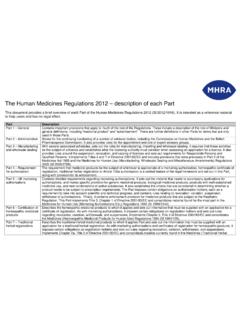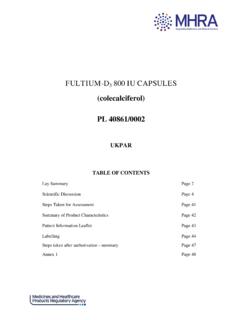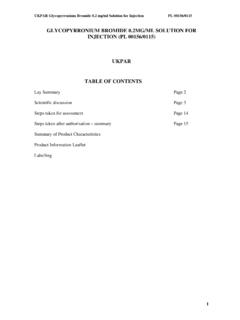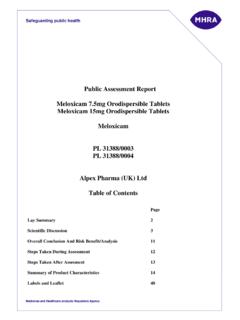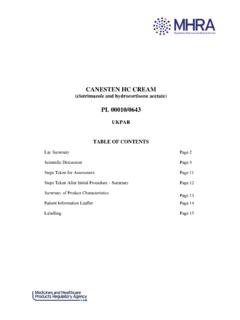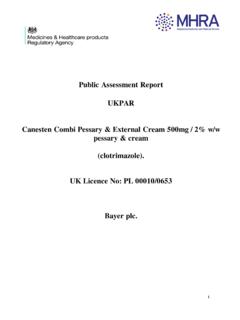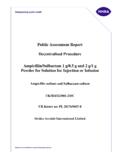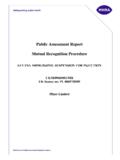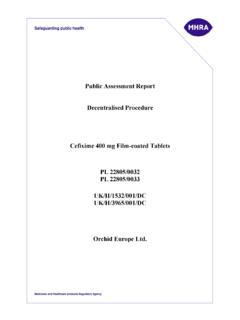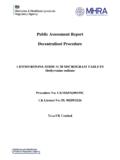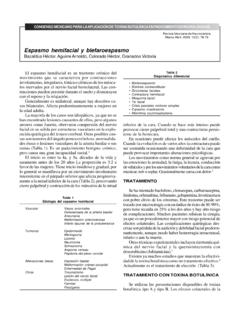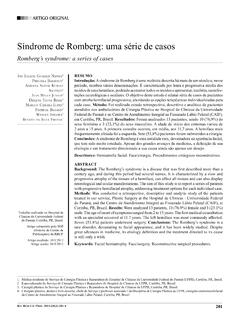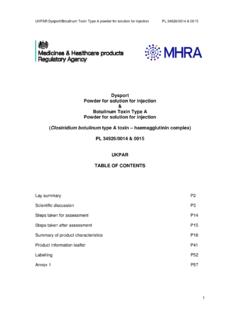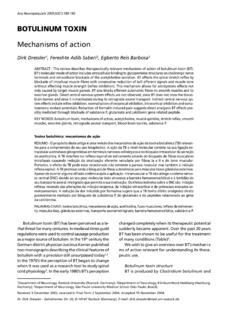Transcription of Botox (Botulinum toxin type A) PL 00426/0118 …
1 Botox ( botulinum toxin type A). PL 00426/0074-0110. PL 00426/0118 -0030. PL 00426/0119-0012. UKPAR. TABLE OF CONTENTS. Lay summary P2. Scientific discussion P3. Steps taken for assessment P141. Steps taken after assessment P142. Summary of product characteristics P143. Product information leaflet P233. Labelling P255. 1. Botox ( botulinum toxin type A). PL 00426/0074-0110. PL 00426/0118 -0030. PL 00426/0119-0012. LAY SUMMARY. The Medicines and Healthcare products Regulatory Agency (MHRA) granted Allergan Limited a variation for the medicinal products Botox 50, 100 and 200 Allergan units . powder for solution for injection (PL 00426/0118 , PL 00426/0074, and PL 00426/0119). on 24th September 2012 to add the new indication for the management of urinary incontinence in adults due to neurogenic detrusor overactivity. This medicine is subject to restricted medical prescription and is already indicated for the symptomatic relief of blepharospasm, hemifacial spasm and idiopathic cervical dystonia (spasmodic torticollis); for the management of severe hyperhidrosis of the axillae, which does not respond to topical treatment with antiperspirants or antihidrotics; and for the prophylaxis of headaches in adults with chronic migraine (headaches on at least 15 days per month of which at least 8 days are with migraine).
2 Botox is also indicated for focal spasticity, including the treatment of dynamic equinus foot deformity due to spasticity in ambulant paediatric cerebral palsy patients, two years of age or older, and wrist and hand disability due to upper limb spasticity associated with stroke in adults. Botox is also indicated for the temporary improvement in the appearance of moderate to severe vertical lines between the eyebrows seen at frown (glabellar lines), in adults <65 years old, when the severity of these lines has an important psychological impact for the patients. Botox contains the active ingredient botulinum toxin type A from Clostridium botulinum at strengths of 50, 100 or 200 Allergan units/vial. Botox blocks the presynaptic release of acetylcholine from the parasympathetic efferent nerves thus paralysing the detrusor smooth muscle, an action similar to that observed in skeletal muscles.
3 Botox also modulates intrinsic bladder reflexes through a multimodal effect on sensory pathways. Such mechanisms may contribute to the efficiency of this treatment and explain why it affects abnormal detrusor contractions more markedly than voluntary bladder emptying. A critical review of the clinical data presented to the MHRA demonstrated that Botox is effective for the management of urinary incontinence in adults due to neurogenic detrusor overactivity. No new safety risks were identified and the safety profile of Botox was considered to be acceptable. It was therefore judged that the benefits of using this product outweigh the risks, hence the variation has been granted. 2. Botox ( botulinum toxin type A). PL 00426/0074-0110. PL 00426/0118 -0030. PL 00426/0119-0012. SCIENTIFIC DISCUSSION. TABLE OF CONTENTS. Introduction P4. Pharmaceutical assessment P5. Pre-clinical assessment P6. Clinical assessment P15.
4 Overall conclusions and risk benefit assessment P140. 3. INTRODUCTION. Based on the review of data on safety and efficacy the UK granted a variation to Allergan Limited for the medicinal product Botox powder for solution for injection on 24th September 2012 in order to add the new indication for the management of urinary incontinence in adults with neurogenic detrusor overactivity. This product is a restricted prescription only medicine. This variation application was submitted as a complex type II. (extended) national variation. Botox is already indicated for the symptomatic relief of blepharospasm, hemifacial spasm and idiopathic cervical dystonia (spasmodic torticollis); for the management of severe hyperhidrosis of the axillae, which does not respond to topical treatment with antiperspirants or antihidrotics; and for the prophylaxis of headaches in adults with chronic migraine (headaches on at least 15 days per month of which at least 8 days are with migraine).
5 Botox is also indicated for focal spasticity, including the treatment of dynamic equinus foot deformity due to spasticity in ambulant paediatric cerebral palsy patients, two years of age or older, and wrist and hand disability due to upper limb spasticity associated with stroke in adults. Botox is also indicated for the temporary improvement in the appearance of moderate to severe vertical lines between the eyebrows seen at frown (glabellar lines), in adults <65 years old, when the severity of these lines has an important psychological impact for the patients. Botox is presented as a white powder for solution for injection in a clear glass vial, with rubber stopper and tamper-proof aluminium seal. Following reconstitution with sterile saline, Botox is injected into the detrusor muscle via a flexible or rigid cystoscope, avoiding the trigone. Patients should be considered for reinjection when the clinical effect of the previous injection has diminished, but no sooner than 3 months from the prior bladder injection.
6 Botox is available as Botox 50 Allergan Units/vial (PL 00426/0118 ), Botox 100 Allergan Units/vial (PL 00426/0074), and Botox 200 Allergan Units/vial (PL. 00426/0119). The active constituent in Botox is a protein complex derived from Clostridium botulinum . The protein consists of type A neurotoxin and several other proteins. Under physiological conditions it is presumed that the complex dissociates and releases the pure neurotoxin. Clostridium botulinum toxin type A neurotoxin complex blocks peripheral acetyl choline release at presynaptic cholinergic nerve terminals. The original licence for Botox was granted on 17th May 1994 and this subsequent variation to extend the indication to include management of urinary incontinence in adults with neurogenic detrusor overactivity was granted on 29th September 2012. 4. QUALITY ASSESSMENT. No new pharmaceutical data have been supplied with these applications and none are required for applications of this type.
7 5. NON-CLINICAL ASSESSMENT. New toxicology data after intradetrusor and peribladder injection of Botox in rats and monkeys have been submitted to support this new indication as the treatment of overactive bladder represents the first use in smooth muscle (Module , TX01064. (single dose in rats); TX02086, TX03052, and TX02042 (single dose in monkeys);. Module , TX05046 (repeat dose in monkeys). Study reports TX05055 and TX07077 have been submitted in Module to support a putative species-specific mechanism of the drug-related effect of bladder stones observed in monkeys. No new pharmacology, pharmacokinetics and drug metabolism studies have been conducted for this indication. Key findings of local and systemic effects following a single intradetrusor Botox . injection in rats and cynomolgus monkeys and a single inadvertent injection in monkeys are summarized in Table 1. Individual summaries including detailed study design and results are presented in Sections and The safety margins are expressed relative to the potential highest anticipated clinical dose of 300 U of Botox for this indication (which is also the highest dose studied in the ongoing Allergan-sponsored phase 3 pivotal studies).)
8 In the clinical studies doses of 200. U or 300 U Botox are administered at a concentration of U/ml and 10 U/ml, respectively; a total volume of 30 ml is administered as 30 injections each of 1 ml. These doses are equivalent to 4-6 U/kg, based on a 50 kg human body weight, as estimated for the evaluation of the safety margins. Evaluation Local effects In the repeat-dose study, there were lymphoid and/or mixed cell infiltrates in the urinary bladder of monkeys treated at all dose levels (12, 24, or 36 U/kg) and also in control animals, in the submucosa and occasionally the muscularis, suggestive of an injection procedure relationship. However, an increased incidence and severity of the mixed cell infiltrate in treated animals examined at Week 42 in comparison to Week 16 indicated a drug-related exacerbation of the inflammatory cell response. These findings were still present after the recovery period at Week 66, although there seems to be a partial resolution.
9 The highest dose (180 U/kg) used in the repeat dose study in cynomolgus monkey, 4. cycles, one every 3 months, attained an animal/human dose ratio in local tissue of approximately 18 and , based on concentration and the anticipated highest dose in humans (10 U/ml; 10 U/site). However, it is noted that no NOAEL could be established neither for the inflammatory infiltrates as local effect in the bladder, nor for the minimal skeletal muscular degeneration, not always recoverable, that was observed in locations distant to the injection site ( thigh and diaphragm), and hence indicative of systemic spread. 6. In rats, there were no local findings attributable to the injection of Botox , other than exaggerated pharmacodynamic effects ( elongation of the cystic trigone and neck, in the high dose level, which corresponded to a concentration up to 100 U/ml, and 25 U/site. However, this highest dose was associated with mortality and/or severe systemic toxicity.)
10 By comparison, in IM studies in rats and monkeys that have been submitted for previously approved indications, administration of 5 U/site Botox in skeletal muscle produced local muscle atrophy, even in the absence of clinical signs of systemic toxicity, within 2 to 4 weeks following injection. Muscle atrophy was not seen in the bladder of rats or monkeys injected with Botox . Human data published in scientific literature indicate that the treatment injections do not appear to produce significant inflammatory changes, fibrosis, or dysplastic changes in the bladder of the patients. In summary, there is no evidence that these animal findings in the bladder are of clinical relevance. Local Effects Peribladder (Inadvertent Injection). Botox injection into peri-bladder tissues in monkeys at up to 20 U/site (up to U/kg total dose) using concentrations up to 50 U/ml were approximately 2-fold greater than the highest intended human local dose of 10 U/site (10 U/ml).
